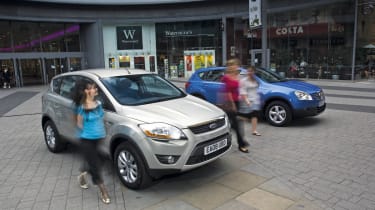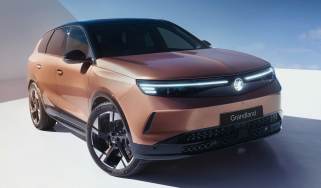Ford Kuga vs Nissan Qashqai
First up, we hit the city streets to see how the Kuga compares to the SUV that’s tailored for urban living.
Like a pair of trendy walking shoes, compact SUVs appeal to our sense of adventure... but they rarely get further off-road than our driveways.
While we all dream of exploring the wilderness, the reality is somewhat different. In truth, most small 4x4s will be confined to the congestion of town centre driving, with only fleeting trips to the kind of locations that fill their glossy sales brochures.
Help is at hand, though, because while old-school 4x4s were heavy and cumbersome on the road, the latest SUVs are designed to flourish in crowded city streets – and none is more capable than the Nissan Qashqai.
It’s not marketed as a fully-fledged off-roader; rather, it’s aimed at urban drivers, and combines the best qualities of a family hatch with the go-anywhere flexibility of an SUV. As a result, the Qashqai has been a smash hit for the firm, and reigns supreme in the city. So, has the Kuga got what it takes to beat the king of the urban jungle?
When it comes to kerbside appeal, the sharp lines of the Ford certainly look good enough take the crown. Until now, the chunky Qashqai has made the best attempt at blending hatchback lines with the raised body and chunky proportions of an off-roader – but the Kuga takes things further.
Ford’s designers clearly know when they’re on to a good thing, and the new SUV borrows heavily from the Mondeo, with the striking headlamps, sculpted body sides and rising waistline all reminiscent of its larger stablemate. Sporty details include air vents on the front wings and twin exhausts. In comparison, the neat Nissan looks a little bland.
The Kuga costs more to buy than its rival, and when you climb aboard it’s easy to see where the money has been spent. Not only is the cabin design more adventurous, but the materials have a higher-quality feel.
Much of its switchgear is shared with the Focus, although that’s no bad thing. All the controls are light and precise, with a smart alloy look to the instruments and console.
We’re not sure about the need for a starter button on a compact SUV, and the ‘Power’ switch on the Kuga’s dashboard is the only real gimmick to be found on either of these models. Buyers who want full keyless functionality will have to pay £250 extra. In contrast, the Nissan’s interior is sombre, although its smart circular air vents add a welcome dose of interest to the otherwise monotone dashboard.
The more expensive Ford also scores well for practicality. While the Qashqai has a traditional tailgate, the Kuga features a two-way bootlid. You can open it normally like the Nissan’s, or if you’re in a tight spot, gain access by lifting the upper section.
When it comes to the weekly shop, the Qashqai takes the initiative. Its 410-litre boot is bigger than the 360-litre Kuga’s – and it’s the same story if you drop the rear seats. The Nissan’s mechanism sees only the backrests fold, giving 1,513 litres of space. Although the Ford’s squabs tilt forward first, the resulting flat load bay has a capacity of 1,355 litres. The Kuga isn’t particularly innovative, either, and does without any sliding function, which would have added some welcome versatility.
From behind the wheel, it’s clear the makers paid close attention to city driving. Both models behave more like cars than off-roaders in the cut and thrust of the town centre. The Kuga’s communicative steering gives greater confidence when nipping down side streets. It’s certainly better than the Qashqai’s set-up, which has an artificial spring-loaded feel as you turn into a corner.
However, the Nissan is just as adept at coping with stop-start motoring, as it has excellent visibility, more compact dimensions and light and easy controls. In terms of acceleration, the cars are evenly matched – the Nissan completes the sprint from 0-60mph in 10.1 seconds, and the Ford is only two-tenths behind.
But the Japanese model can’t compete with the Kuga’s grip or agility. Get caught out on a slippery roundabout, and the Qashqai’s front end will wash wide before its rival’s.
As with the Nissan, a rear view camera is available as an option on the Ford, and we’d definitely recommend it. The Kuga’s size and distinctive rump can be hard to judge from the driver’s seat, and it could save you money in repair bills in the long run.
So the Ford looks better and is clearly the more practical choice, and it enjoys a slight dynamic edge over the class champion. But does that justify its £3,000 price premium over this top-spec Nissan?
Economy
We were surprised to see that the Nissan’s financial downfall is depreciation. While the Kuga is set to retain a credible 52.1 per cent of its value after three years, the Qashqai holds on to only 43.5 per cent. Having spent most of its time in town in this test, the Nissan’s 30.4mpg economy is acceptable. Relatively high emissions are less impressive, though, and make the Qashqai a costly company car option – a 27 per cent tax rating places it third in this group.



